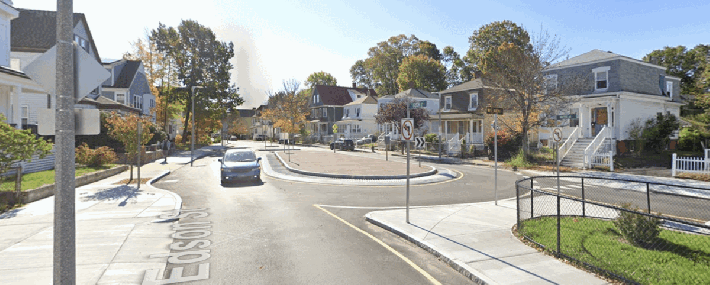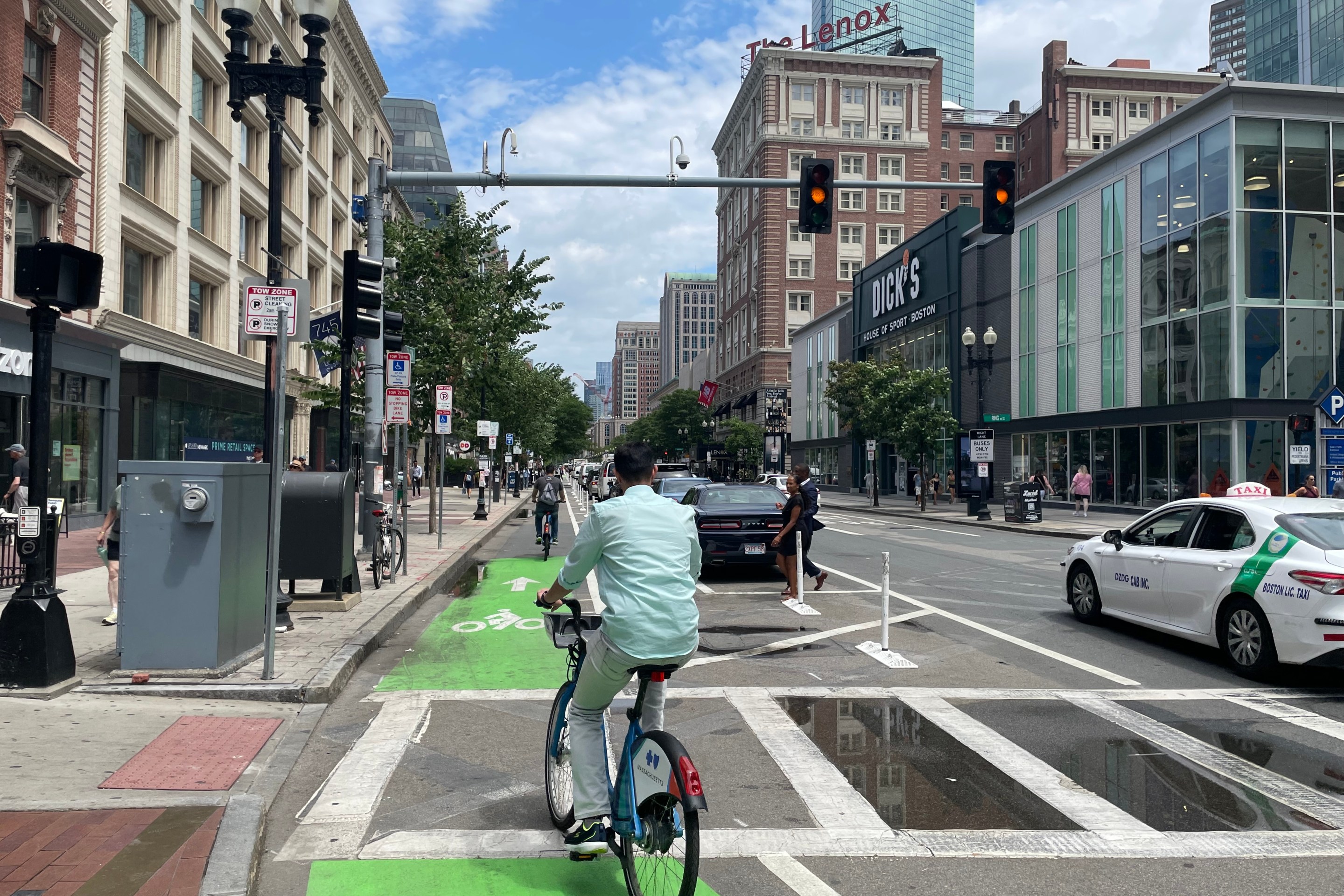Earlier this fall, Stefanie Seskin, the longtime Director of Active Transportation at the Boston Transportation Department, left her job in municipal government to join the executive team of the National Association of City Transportation Officials (NACTO).
We recently chatted with Seskin to learn more about her new role at NACTO, and to reflect on the changes she witnessed during her 8-year career at City Hall. This is a lightly-edited transcript of our conversation.
StreetsblogMASS: Tell me about your new job with NACTO – what’s your job and what have you been working on?
Seskin: I am the new Director of Policy and Practice on the leadership team at NACTO. So I'm responsible for directing our strategy and approach toward changing paradigms through transportation policy and street design so that we’re getting safe, equitable, sustainable outcomes in our cities.
And I have a multidisciplinary team – we have our communications staff, our design and technical folks, as well as a soon-to-be-hired Senior Manager for Policy. And together we’re all partnering with and lifting up all of the work that our member cities and transit agencies are doing, or trying to do. We just announced we have 100 member agencies now, which is a pretty big milestone for NACTO.
To put this in more concrete terms, what am I doing right now is I’ve been providing some strategic direction and help on our next edition of the Urban Bikeway Design Guide, and thinking about what our major federal policy initiatives are going to be for next year and going into the future.
We’re also currently working on the MUTCD (Manual of Uniform Traffic Control Devices) update, and vehicle design standards. And some of that is in partnership with other national organizations like Transportation for America, NRDC, League of Bicyclists, all of those good folks in D.C.
StreetsblogMASS: How do you think your experience in Boston will help you in this new role?
Boston is one of the member cities for NACTO. Understanding what it’s like to be on the inside – the sort of grounding in reality of what it’s really like to be in a transportation agency that’s trying to rethink streets and rethink community engagement and rethink our policies – having that experience hopefully means that I’m better able to manage our work at NACTO so that it is as helpful as it can be for members.
We just brought on our Director of Engagement a few months before me, Alana Brasier, and she is also coming directly from a member city. So I’m excited to be working alongside her as we’re both navigating this shift from working in local government to working at a nonprofit, but also in comparing stories, and insights into how our cities actually operate.
You’d been at City Hall a long time, and saw a lot of changes there. When were you hired, and what were the different positions you held?
So I held the same position the whole time with the same title. I was there for just over 8 years: I think it was 8 years, one month and like 5 days (laughing), but who’s counting though?
So I had the same job title, but obviously lots of things changed over 8 years. We had three mayors; I served under Commissioner Fiandaca, then it was Commissioner Rooney, and then we sort of switched to the Chief of Streets model, so there were quite a lot of of institutional, internal changes happening, even if it didn’t always look like it from the outside.
But also the team that I led grew from four people, and some part-time folks, to a group of 12 or 13, plus part-timers. So the scale of the work significantly ramped up. The responsibilities ramped up, the outcomes also really ramped up.
And I had some really great opportunities to shift the way that the city approached street design, and we’re really – there’s always ways to be better, but we were able to change the way a lot of folks thought about bike lanes, about traffic calming, about how a pedestrian encounters the street.
And those were all really meaningful and important, and as a resident, I’m excited to be able to continue to see where my colleagues keep moving the city forward.
There have been some pretty big changes in the city over the past 8 years. In addition to your own team growing and getting more projects done, how has the culture at City Hall changed, both from elected officials and from other city departments, with respect to thinking about street safety and active transportation?
Yeah, I guess just to clarify, I think that my team was part of it, but there was a pretty big overall culture shift during that time, and across different agencies, in thinking about the role of transportation and achieving a lot of goals that we have as a city.
And I think there is a lot more openness across agencies that might historically have been a little grumpy about some of the changes that we were making. They still may be a little grumpy, but maybe a little less grumpy than they had been in the past.
Change is hard, and Boston is a historic city and we really value the past, and try to honor that, but to meet our future challenges, you know, we need to change. There was a lot of work that went into building relationships and obviously there were a lot of external factors – our advocacy community, folks that came into office.
I remember when I first started, Mayor Wu was still a new, first-term City Councilor, and she was so interested in learning. She invited (Northeastern University Civil Engineering) Professor Peter Furth to give presentations to the City Council, and to see how that influenced her thinking in her mayoral campaign, and then to be elected – that kind of a shift is a huge win for Boston.
And I think a lot of our council members are interested in seeing change in their communities, they see the need for safer streets. They hear it from their residents, and a lot more residents are interested in seeing change too, maybe more than people thought they would be.
Was there anything you were still working on at City Hall that was really difficult to tear yourself away from?
Leaving was definitely bittersweet. One of the great things about working in local government and in transportation is that there is always more work to do. It doesn’t matter how long you stay, there will always be projects that you wish you got to finish.
I’m really excited about all of the pieces that were starting to come together around the massive street design projects, and the network-level changes through our much-expanded speed humps program, and having a real commitment to a connected bike network. And also, some of the federal grants that we won recently, like the Blue Hill Avenue grant and the Roxbury corridors.
It’s also really interesting to have seen projects that are of such a large scale that they’re still going after all these years – I remember going to meetings for the Allston I-90 multimodal project within the first month that I started.
As I would have loved to see more of that project be solidified, I could also see the shift in thinking. The Task Force members have been so adamant that they deserve better, and it’s exciting and gratifying to see some of the shifts in perspective from the state and the project team over time.
What are some of the accomplishments you’re proudest of working on for the city?
I think I’m proudest of the work I put into creating real relationships with community members and stakeholders, particularly in the neighborhood slow streets program, which really laid the groundwork for wider-scale changes.

For the slow streets program, we installed some mini-roundabouts in Dorchester, and it was so gratifying to see these intersections that were so confusing – you would just feel nervous approaching them, even if there wasn’t someone driving by, and knowing that kids are walking to school or waiting for the bus there. And this is the environment that they were in. So being able to see that change and the feeling of the neighborhood change as a result – I feel really good about those projects.
And then, for as long as the construction has taken I’m also really excited about Tremont Street in the South End. It set the bar for a lot of projects that are coming up, in terms of how we think about street space and time at traffic signals and design elements that we want to repeat elsewhere. So really getting it right there, I think will continue to reverberate past that project.






